Learning about Automatic symbolic MPO construction
Reference
Import modules
[1]:
import sympy
from pympo import (
OpSite,
SumOfProducts,
assign_core,
get_UVE,
show_assigns,
show_bipartite,
show_maximal_matching,
show_min_vertex_cover,
)
Define operator
chose favorite Hamiltonian operator.
1-D Ising model
[2]:
Ising = SumOfProducts([])
J = sympy.Symbol("J")
h = sympy.Symbol("h")
ndim = 5
spin_ops = [OpSite(r"\hat{s}" + f"_{i}", i) for i in range(ndim)]
for i in range(ndim - 1):
Ising += -J * spin_ops[i] * spin_ops[i + 1]
Ising -= h * spin_ops[i]
Ising += -h * spin_ops[-1]
Ising = Ising.simplify()
print(f"{Ising.ndim=}, {Ising.nops=}")
Ising.symbol
Ising.ndim=5, Ising.nops=9
[2]:
[3]:
Hamiltonian = Ising
Initialze list of assignment information
W_assignsholds which row and column each operator is assigned to on each site.coef_siteholds which site coefficient is multiplied to operator.Wis a generated MPO.
[4]:
W_assigns: list[list[int]] = [
[k for _ in range(Hamiltonian.ndim)] for k in range(Hamiltonian.nops)
]
coef_site: list[int] = [Hamiltonian.ndim - 1 for _ in range(Hamiltonian.nops)]
W: list[sympy.Basic] = []
n sum-of-product terms can be naively converted to a MPO with bond dimension M=n. The green edges indicate the mulitplication of the coefficient to the operator.
[5]:
show_assigns(Hamiltonian, W_assigns, coef_site)
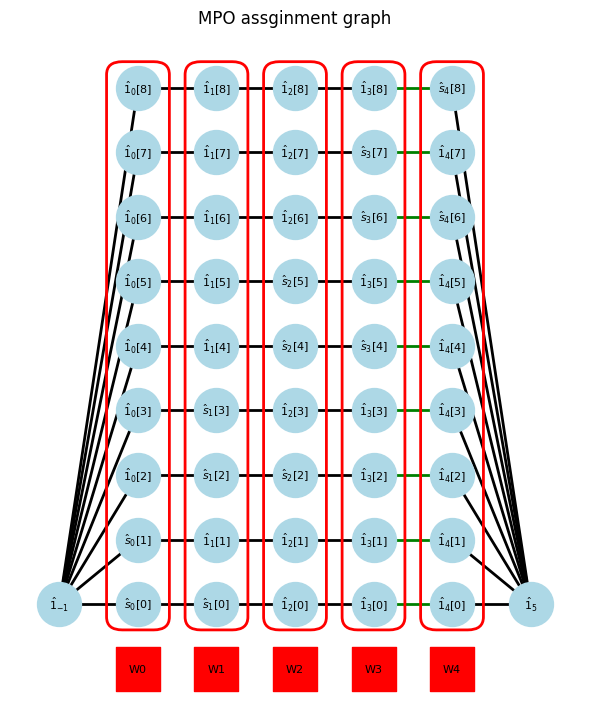
At first, we focus on the gap between 0th and 1st site. The opearator in left blocks and right blocks can be interpreted as a bipartite graph.
[6]:
U, V, E, E_assigns = get_UVE(Hamiltonian, W_assigns, 0)
G, pos = show_bipartite(U, V, E)
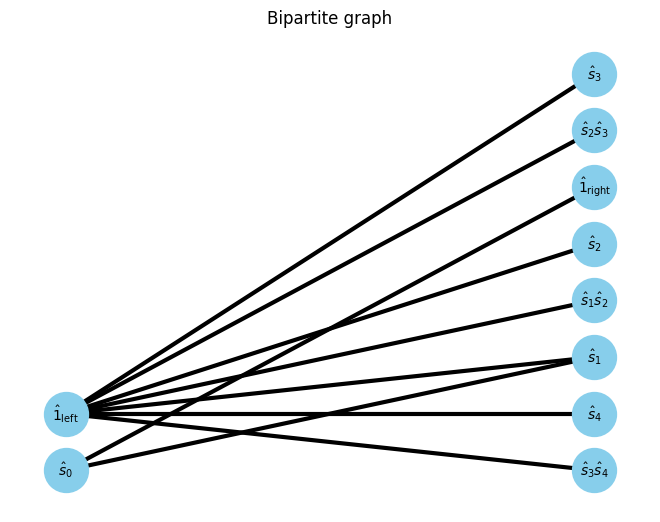
Then, find maxmatching of the bipartite graph
[7]:
max_matching = show_maximal_matching(G, pos)
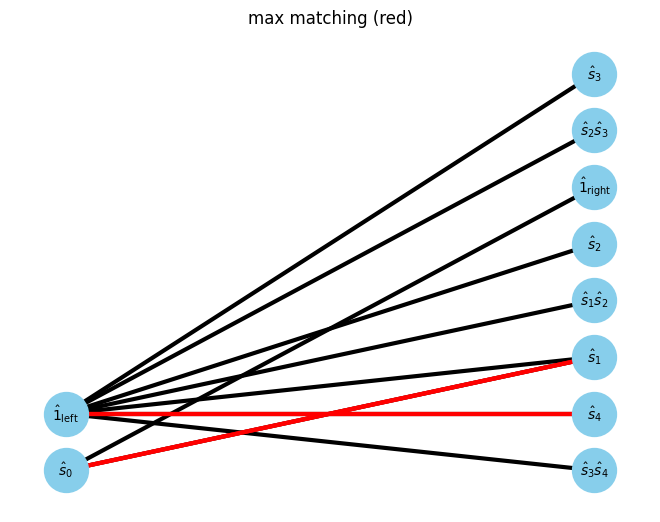
In bipartite graph, the minimum vertex cover (green vertex) can be found from the previous maxmatching.
[8]:
min_vertex_cover = show_min_vertex_cover(G, pos, max_matching)

For each minimum vertex covers,
if the vertex cover is in the left side, we can extract normal site operator.
if the vertex cover is in the right side, we can define the complementary operator connected to the vertex cover.
And then, we can assign normal and complementary operators to MPO.
[9]:
Unew, Wi = assign_core(
min_vertex_cover=min_vertex_cover,
U=U,
V=V,
E=E,
operators=Hamiltonian,
isite=0,
W_assigns=W_assigns,
E_assigns=E_assigns,
coef_site=coef_site,
visualize=True,
)

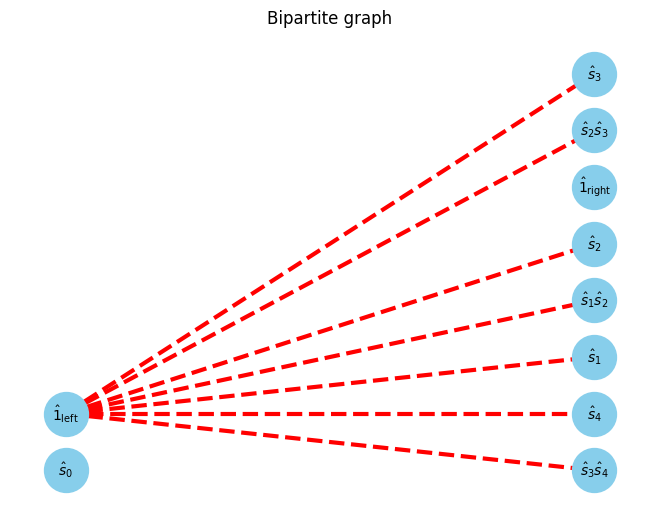
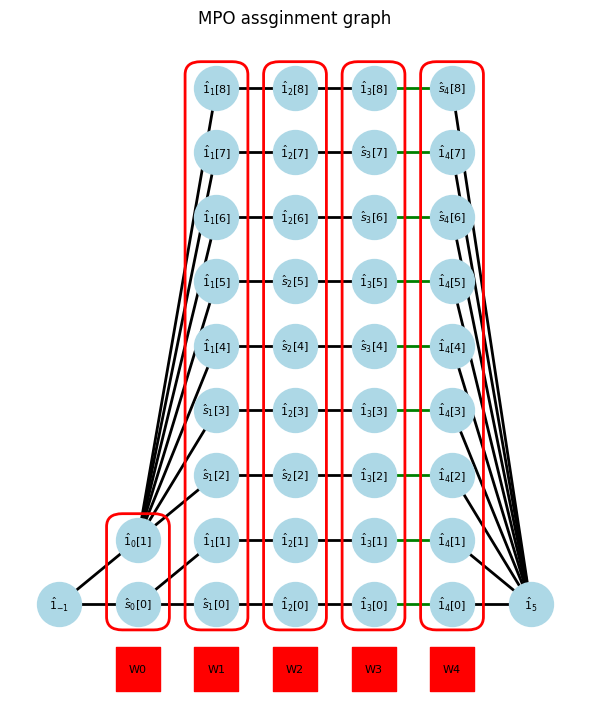
[10]:
W.append(Wi)
display(*W)
Repeat the same procedure till the end of the MPO.
[11]:
assign_core??
Signature:
assign_core(
*,
min_vertex_cover: list[str],
U: list[str],
V: list[str],
E: list[tuple[str, str]],
operators: pympo.operators.SumOfProducts,
isite: int,
W_assigns: list[list[int]],
E_assigns: list[tuple[str, str]],
coef_site: list[int],
visualize: bool = True,
) -> tuple[list[str], sympy.matrices.dense.MutableDenseMatrix]
Source:
def assign_core(
*,
min_vertex_cover: list[str],
U: list[str],
V: list[str],
E: list[tuple[str, str]],
operators: SumOfProducts,
isite: int,
W_assigns: list[list[int]],
E_assigns: list[tuple[str, str]],
coef_site: list[int],
visualize: bool = True,
) -> tuple[list[str], sympy.Matrix]:
"""
Assigns core vertices and updates the bipartite graph representation.
Parameters:
-----------
min_vertex_cover : list[str]
The minimum vertex cover of the bipartite graph.
U : list[str]
List of vertices in set U.
V : list[str]
List of vertices in set V.
E : list[tuple[str, str]]
List of edges in the bipartite graph.
operators : SumOfProducts
The operators to be assigned.
isite : int
The current site index.
W_assigns : list[list[int]]
The assignments of W.
E_assigns : list[tuple[str, str]]
The assignments of edges.
coef_site : list[int]
The coefficient sites.
visualize : bool, optional
Whether to visualize the bipartite graph and assignments (default is True).
Returns:
--------
tuple[list[str], sympy.Matrix]
A tuple containing the updated list of vertices in U and the matrix Wi.
"""
Unew: list[str] = [] # U[1..i]
unique_ops = []
update_coef_ops = []
for j, vertex in enumerate(min_vertex_cover):
if vertex in U:
Unew.append(vertex)
# remove the edge connected to the vertex
retained_E = []
remove_E = []
for edge in E:
if vertex != edge[0]:
retained_E.append(edge)
else:
remove_E.append(edge)
represent_ops = {}
for k, op in enumerate(operators.ops):
if E_assigns[k] in remove_E:
opsite = op[isite]
W_assigns[k][isite] = j
if opsite not in represent_ops:
unique_ops.append(k)
represent_ops[opsite] = k
else:
assert vertex in V, f"{vertex=} is not in {V=}"
retained_E = []
remove_E = []
vertex_U_concat = 0
for edge in E:
if vertex != edge[1]:
retained_E.append(edge)
else:
remove_E.append(edge)
represent_ops = {}
for k, op in enumerate(operators.ops):
if E_assigns[k] in remove_E:
W_assigns[k][isite] = j
opsite = op[isite]
if coef_site[k] >= isite:
unique_ops.append(k)
elif opsite not in represent_ops:
unique_ops.append(k)
represent_ops[opsite] = k
op_0_to_isite = op[0 : isite + 1]
if coef_site[k] < isite:
vertex_U_concat += op_0_to_isite
else:
# coef_site[k] = isite
update_coef_ops.append(k)
vertex_U_concat += op.coef * op_0_to_isite
Unew.append(sympy.srepr(vertex_U_concat))
if visualize:
pympo.visualize.show_bipartite(U, V, E, retained_E)
E = retained_E
for k in update_coef_ops:
coef_site[k] = isite
if visualize:
pympo.visualize.show_assigns(operators, W_assigns, coef_site)
if isite == 0:
left_dim = 1
else:
left_dim = max([assign[isite - 1] for assign in W_assigns]) + 1
if isite == operators.ndim - 1:
right_dim = 1
else:
right_dim = len(Unew)
right_dim_debug = max([assign[isite] for assign in W_assigns]) + 1
assert (
right_dim == right_dim_debug
), f"{right_dim} != {right_dim_debug}, {[assign[isite] for assign in W_assigns]}"
Wi = sympy.zeros(left_dim, right_dim)
for k in unique_ops:
op = operators.ops[k]
if isite == 0:
left_index = 0
else:
left_index = W_assigns[k][isite - 1]
if isite == operators.ndim - 1:
right_index = 0
else:
right_index = W_assigns[k][isite]
if sympy.latex(op[isite]) == r"\hat{1}" + f"_{isite}":
opisite = 1
else:
opisite = op[isite]
# there are three cases
# 1. W[a,b] = x_i
# 2. W[a,b] += x_i
# 3. W[a,b] += coef * x_i
if coef_site[k] == isite:
# case 3
Wi[left_index, right_index] += op.coef * opisite
elif coef_site[k] < isite:
Wi[left_index, right_index] += opisite
else:
# case 1
if Wi[left_index, right_index] == 0:
Wi[left_index, right_index] = opisite
else:
assert (
Wi[left_index, right_index] == opisite
), f"{Wi[left_index, right_index]=} while {op[isite]=} when {coef_site[k]=}, {isite=}"
return Unew, Wi
File: ~/GitHub/PyMPO/src/pympo/bipartite.py
Type: function
[12]:
for isite in range(1, Hamiltonian.ndim):
print(f"{isite=}")
U, V, E, E_assigns = get_UVE(Hamiltonian, W_assigns, isite, Unew)
G, pos = show_bipartite(U, V, E)
max_matching = show_maximal_matching(G, pos)
min_vertex_cover = show_min_vertex_cover(G, pos, max_matching)
Unew, Wi = assign_core(
min_vertex_cover=min_vertex_cover,
U=U,
V=V,
E=E,
operators=Hamiltonian,
isite=isite,
W_assigns=W_assigns,
E_assigns=E_assigns,
coef_site=coef_site,
visualize=True,
)
W.append(Wi)
display(*W)
W_prod = sympy.Mul(*W)
print(*[f"W{i}" for i in range(isite + 1)], "=")
display(W_prod.expand())
isite=1
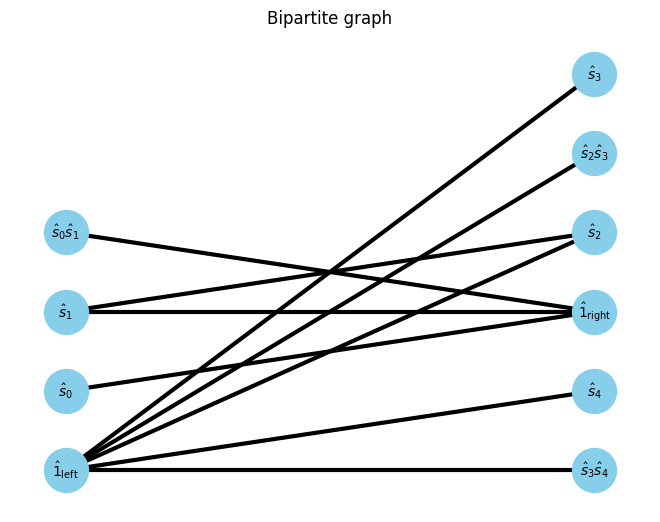
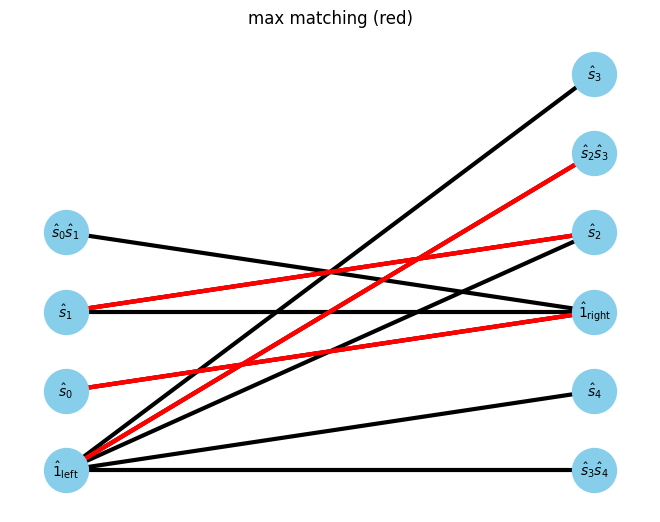
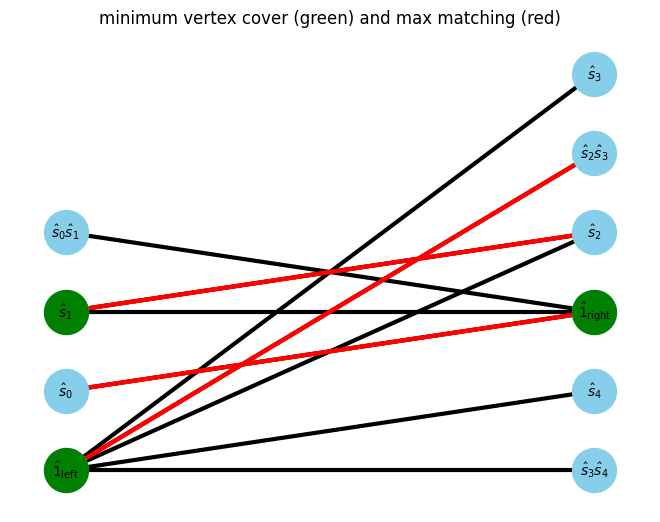


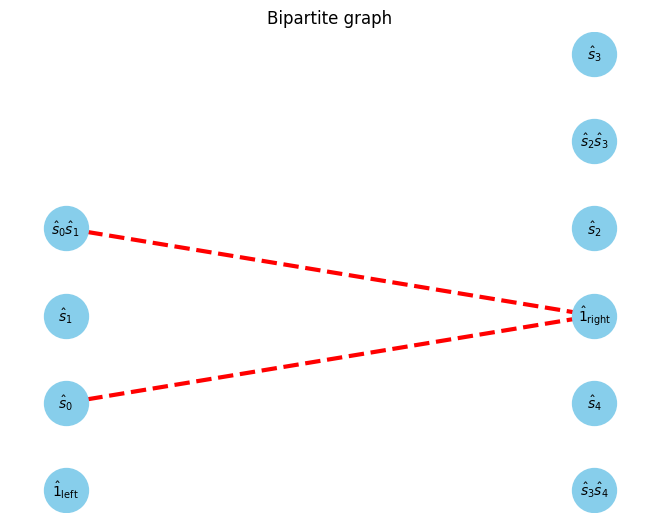
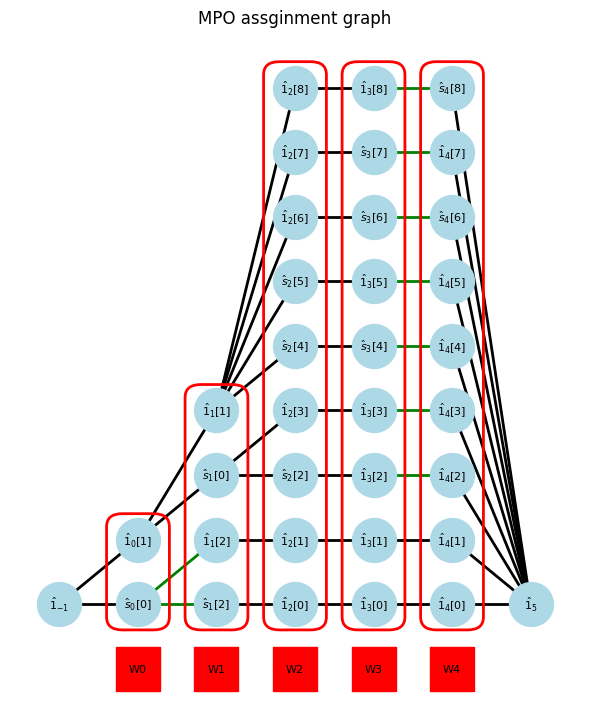
W0 W1 =
isite=2

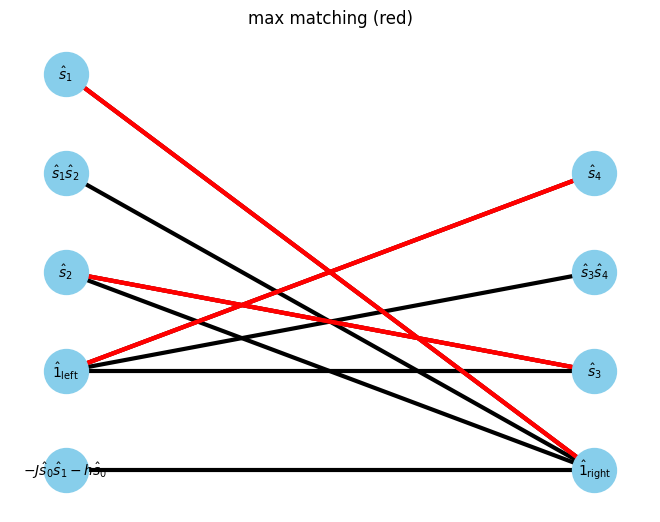
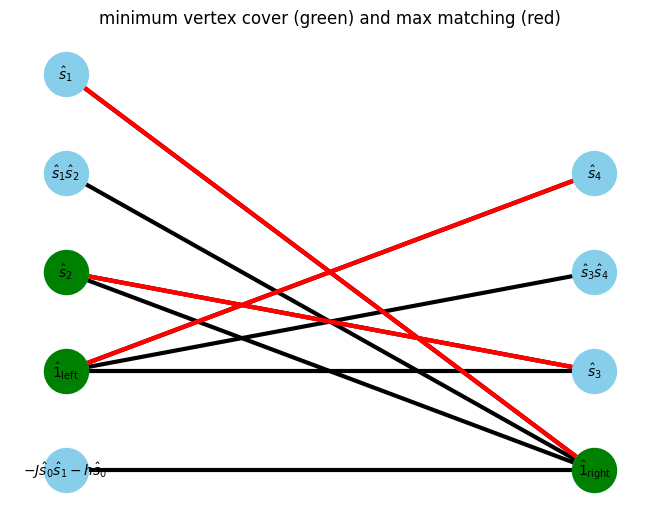
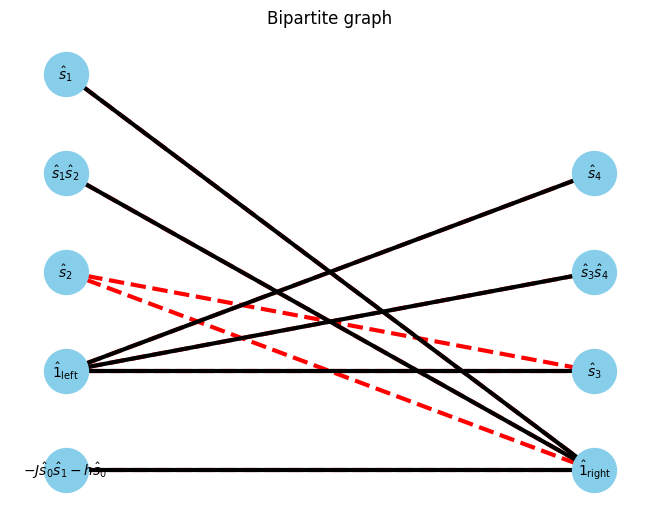

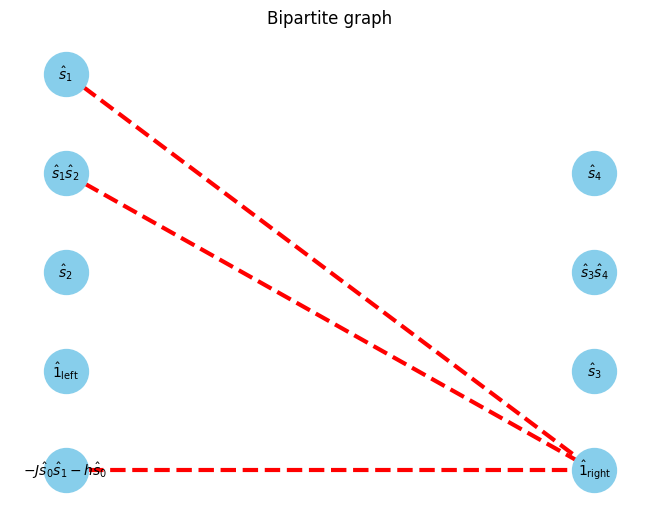
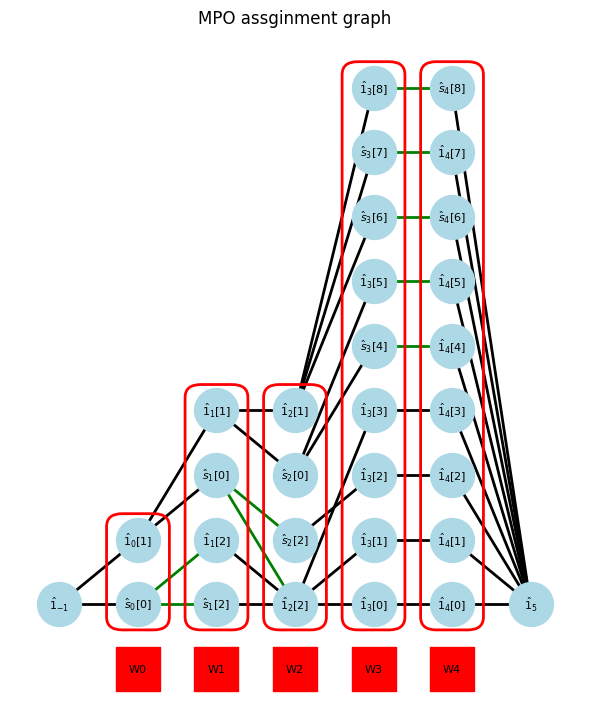
W0 W1 W2 =
isite=3

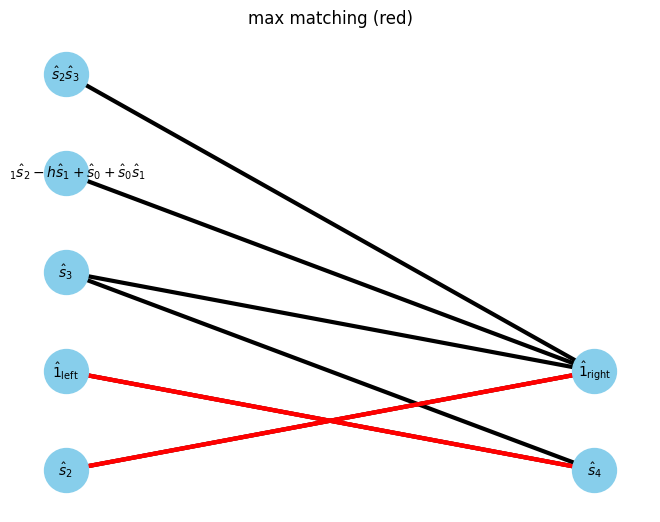
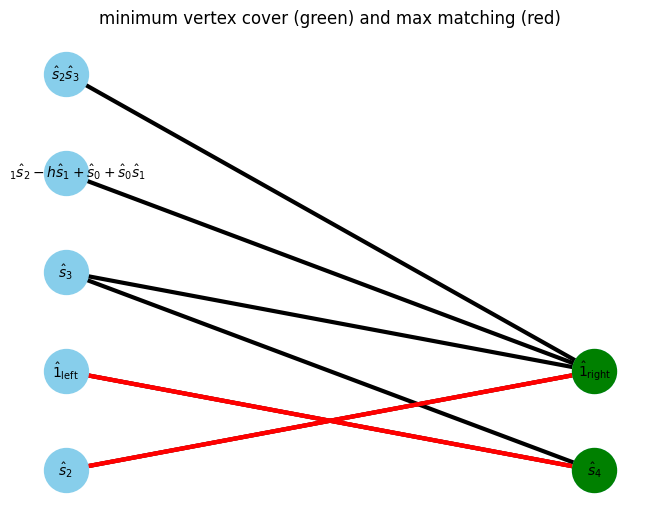
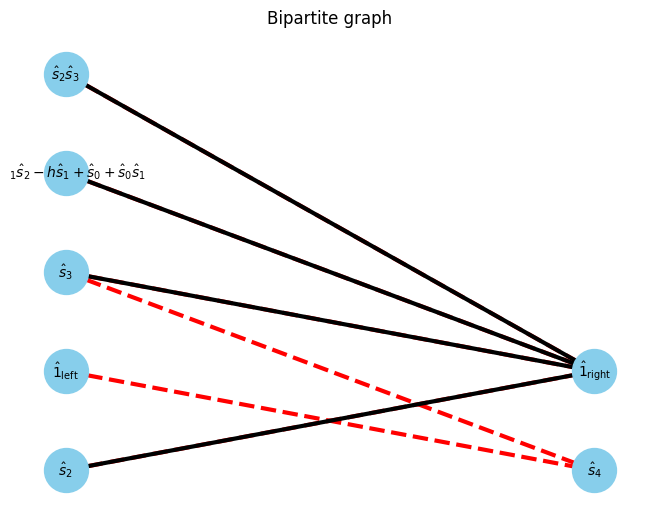
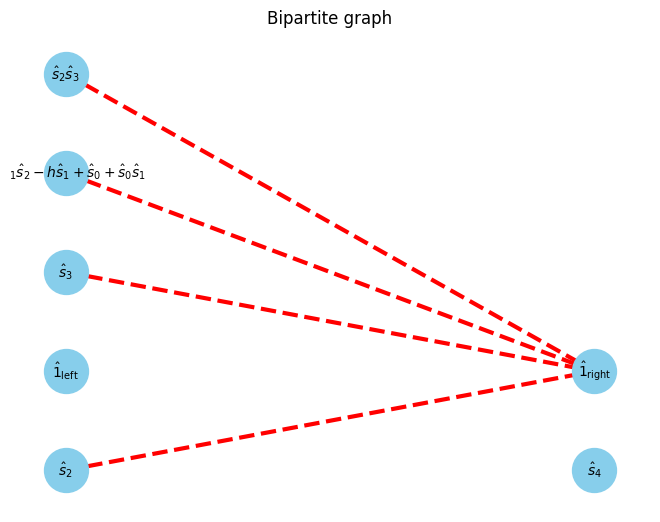
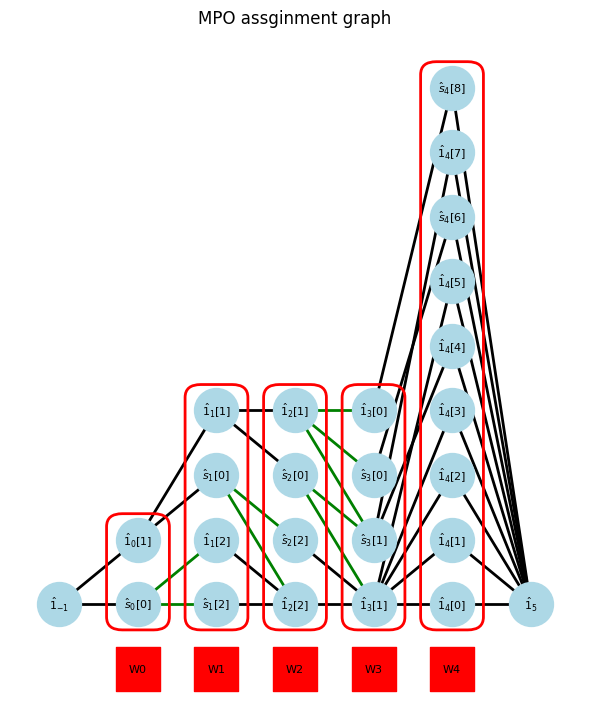
W0 W1 W2 W3 =
isite=4
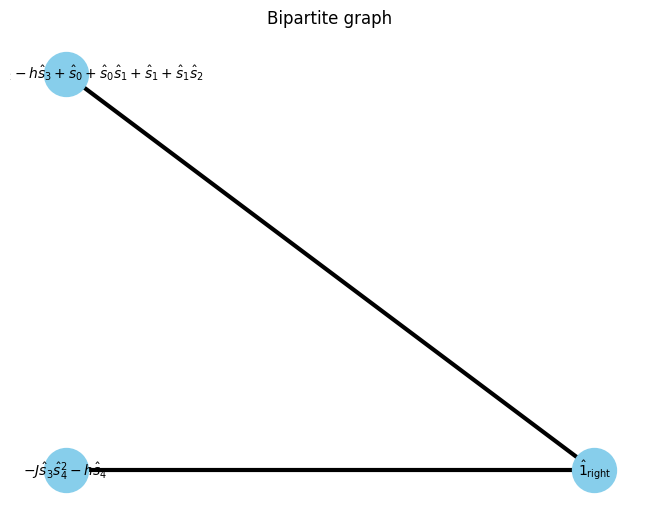
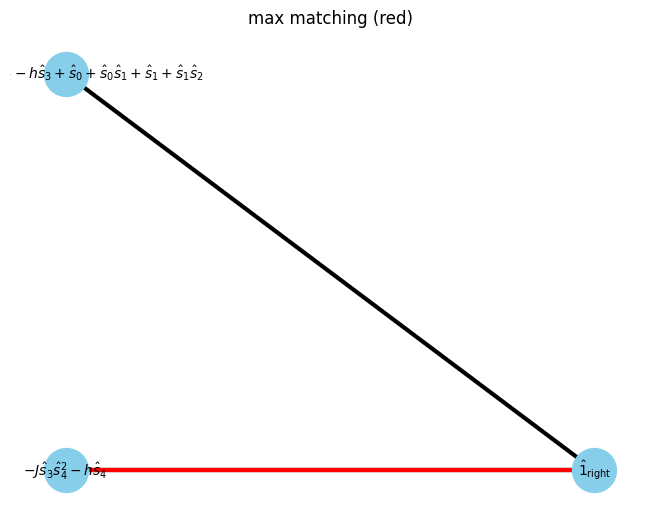

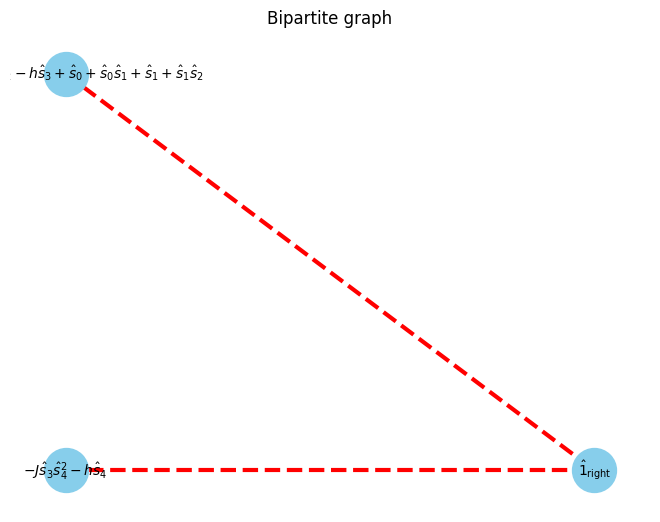

W0 W1 W2 W3 W4 =